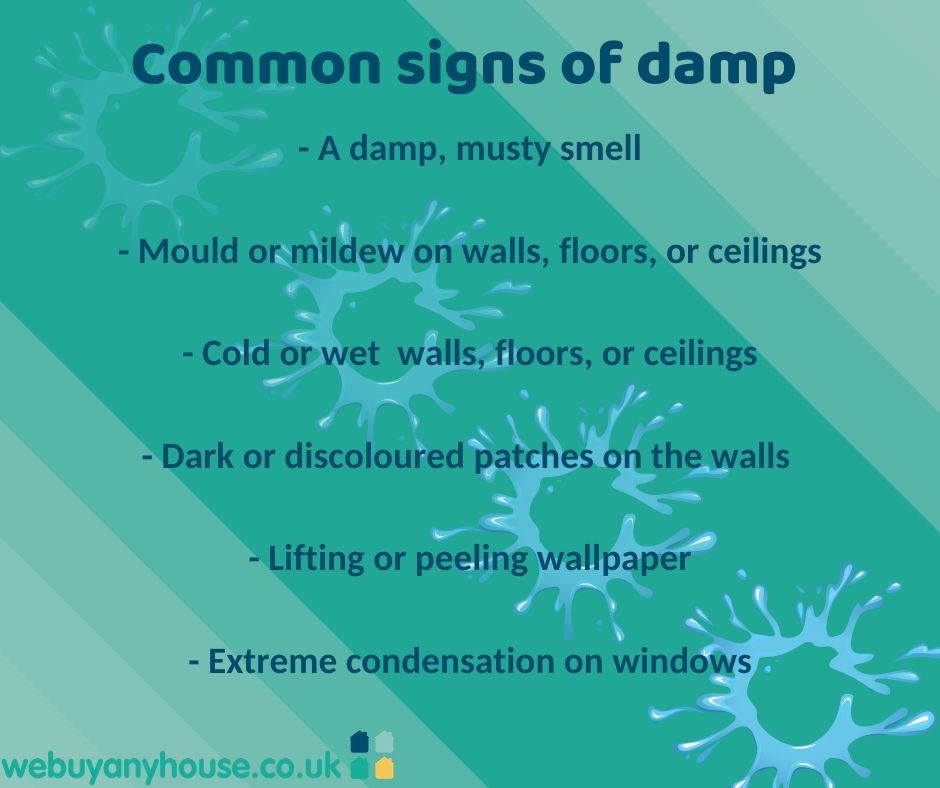How do I know if my house is damp?
How do I know if my house is damp? A damp, musty smell Mould or mildew on walls, floors, or ceilings Cold or wet walls, floors, or ceilings Dark or discoloured patches on walls or plastering Lifting or peeling wallpaper Heavy condensation on windows. As a homeowner, your house being damp can cause lots of

How do I know if my house is damp?
- A damp, musty smell
- Mould or mildew on walls, floors, or ceilings
- Cold or wet walls, floors, or ceilings
- Dark or discoloured patches on walls or plastering
- Lifting or peeling wallpaper
- Heavy condensation on windows.
As a homeowner, your house being damp can cause lots of problems. Catching damp early on will help prevent the damage that it can cause. We Buy Any House explore the main signs of damp and how you can fix it.
Get a cash offer for your house today!
What are the common signs of damp?
Several signs will indicate if your house is damp, depending on the severity of your damp issue. The main symptoms are –
- A damp, musty smell
- Mould or mildew on walls, floors, or ceilings
- Cold or wet walls, floors, or ceilings
- Dark or discoloured patches on walls or plastering
- Lifting or peeling wallpaper
- Heavy condensation on windows.
There are different types of damp – the most common are penetrating damp, which spreads horizontally or downwards across walls, and rising damp, which will grow vertically. Rising damp has some other signs that you should keep an eye out for –
- Damp patches at the bottom of walls that are gradually spreading upwards
- Damp skirting boards, or plaster
- Rotting skirting boards, or plaster
- Wet or lifting tiles, vinyl’s, or carpets
- Peeling paint or wallpaper
- White, salt-like powder coating the walls
- Yellow or brown tide marks on the walls.

What about outside the house?
Damp can affect a house both inside and outside of the property. If you’re suffering from penetrating damp, it’s often due to structural issues. This can be damaged gutters, cracks in the brickwork or problems with the roof. Old bricks can also become porous, which lets in water. If this is the cause of your damp, you will usually see wet patches on the exterior walls.
How do I check for damp?
There are a couple of ways to check for damp. The easiest way to identify damp is by assessing the walls, floors, and ceilings of your house for any evidence. If any of the floorings have lifted, try to look underneath and see if you can spot any damp. You may only notice the slight smell at first.
If you suspect that you’ve got rising damp, run your hands along the walls you think are affected. You may be able to feel plaster salt – a white powdery substance that gets washed out of brickwork in damp areas. If the damp wall is wallpapered, when you run your hands over it, you might hear a slight crunching sound from the plaster salt.
‘Can We Buy Any House help me sell my house?’ – Learn how we can help you today!
Can I fix it on my own?
Depending on the amount of damp you have, you may be able to deal with it yourself. Dehumidifiers can help absorb the moisture in the air that damp thrives on, and repainting affected walls with an anti-mould paint can also stop the growth of mould. However, it could be a deeper issue, and so if you’re concerned about damp, it’s best to consult a professional. If there is an issue with the exterior of the property, the longer you leave it, the worse it will get. The mould that often grows on damp areas can also cause minor health issues, especially for young children, older people or anyone who has asthma. Dealing with it as soon as you see the signs of damp is the best course of action.

If your house has damp and you’re trying to sell, you will likely find that buyers are hesitant. Here at We Buy Any House, we can still make you a free offer for your property and see how we can help you sell it.
We buy any home in as little as 7 days, or timescales to suit you. Head to our website for more information.
